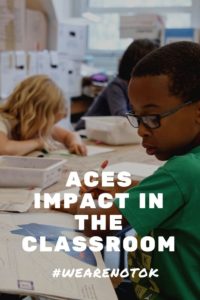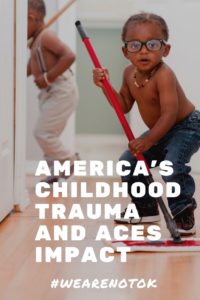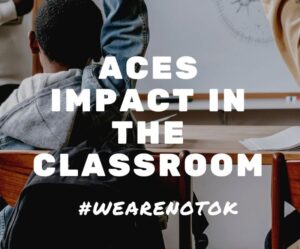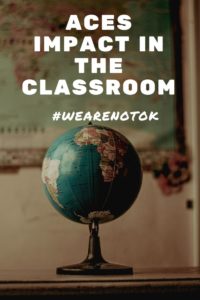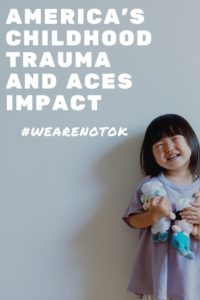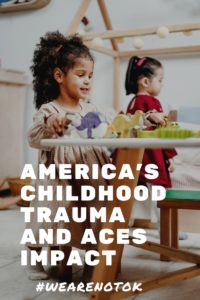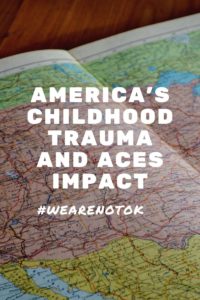California’s Surgeon General Nadine Burke Harris has declared Adverse Childhood Experiences a public health problem and public school crisis in her state.
About 1/3 of all state ward children (nationally) are forced onto psychotropic medications. Suicide is now the 2nd leading cause of death among 10 to 24 year olds.
Over 1 million children under 6 are prescribed psychiatric drugs in America today. In 2014, 20,000 one and two year old’s were on Prozac like drugs & *Johnson & Johnson was fined billions of dollars for illegally selling those drugs to pediatricians for use on very young children…
The child psychiatrist working my child protection cases had hundreds of State Ward kids to watch over and no way to provide a consistent presence or adequate safety program to her clients. Not her fault. It’s all about resources for at risk children and how our community values other peoples children.
For a very long time, we have been stuffing suicidal children overnight in emergency room beds because there are not enough mental health beds and staff to deal with them (and we wonder why kids cut themselves, stab schoolmates, punch teachers and attempt suicide). Suicide rates in Anoka County almost doubled from 1999 to 2015.
- There have been 1000 emergency psychiatric visits monthly at Hennepin Healthcare many of them children (a single metro hospital).
- Multiple mental health facility closures at MN’s rural hospitals, hospitals turning away mental health patients , dysfunctional group homes, communities refusing to allow mental health group homes and services in the neighborhood are exacerbating already serious troubleq we have facing this crisis.
- The costs of crime & mental health disorders are horrendous – suicides from trauma and abuse are common and predictable.
- These MPR short stories clearly articulate the sadness families face dealing with mental health crisis in my state of Minnesota.
It’s time we embraced the problem with the intention of solving it.
The crisis in children’s mental health Post COVID is beginning to (NYTimes) appear in our communities.
Here are some ideas from the article above;
- States must create their own roadmaps for success. Fortunately, there are models to serve as guides. For example, New Jersey’s “Road Forward” initiative provides $1.2 billion in federal COVID-19 relief funds to school districts across the state for students and educators. This includes a $30 million mental health grant that will help school districts facilitate services and invest resources in a way that will best serve the unique needs of their community.
- Our federal government has a role to play as well. Representatives Grace Napolitano (D-Calif.) and John Katko (R-N.Y.) introduced the Mental Health Services for Students Act, which would create a $200 million grant program to fund mental health services in schools. If signed into law, this would be a major step in the right direction.
Additional Resources
- Psychrights.org website
- Treatment Planning and Medication Monitoring Were Lacking for Children in Foster Care Receiving Psychotropic Medication, by the Office of the Inspector General, U.S. Department of Health and Human Services, September 17, 2018.
- Psychotherapy v. Medications: Let us Court the Ways, National Alliance of Professional Psychological Providers, Feb, 2017, Vol 12 No. 2.
- Opinion: Misguided mental health system needs an overhaul, by Jim Gottstein, January 13, 2016, Alaska Dispatch News.
- Escape from British Columbia, Rob Wipond, Focus, November-December, 2016.
- The Case Against Antipsychotics: A Review of Their Long-term Effects, by Robert Whitaker, Mad In America Foundation, July, 2016.
- Open dialogues in the present and the future – new developments, byJaakko SeikkulaMay 13, 2016.
- The Search for Schizophrenia Genes: Larger and larger samples are showing smaller and smaller effect sizes. What does this mean for drug development, clinical practice, and our view of mental illness? by Jonathan Leo, Slate, February 5, 2016.
- PsychRights and Committee for Truth in Psychiatry submission to FDA opposing reclassification of electroshock machines, March 25, 2016.In search of an evidence-based role for psychiatry, by John Read, Olga Runciman, & Jacqui Dillon, Future Science, February 22, 2016 (online).
- Soldiers Of The Iraq/Afghanistan Era Dead Of Sudden Cardiac Death Probably Due To Prescription Antipsychotic & Other Psychotropic Drugs, by Fred A. Baughman, Jr., MD, Presented at the 22nd Annual Combat Stress Conference May 1-3, 2015 Carlsbad, CA.
- Drugging Our Kids: Children in California’s foster care system are prescribed unproven, risky medications at alarming rates, story by Karen De Sa, San Jose Mercury News, August 25, 2014.
- Feds Pay for Drug Fraud: 92 Percent of Foster Care, Poor Kids Prescribed Antipsychotics Get Them for Unaccepted Uses, by Art Levine, Huffington Post, April 30,2015.
- Letter From Nine Mental Health Experts To Funders And Ethics Committee About Ketamine + Electroshock Therapy Study, John Read Blog, June 21, 2014.
- Revisiting a debate: Does psychiatry overmedicate? by Stacey Burling, The Philadelphia Enquirer, April 10, 2014.
- The Drugging of the American Boy, Esquire, by Ryan D’Agostino, March 27, 2014.
- Department of Justice letter stating askin about psychiatric diagnosis on bar application violates federal law, January 21 2014.
- Barry Pollack letter to the Commissioner of the Massachusetts Department of Mental Health regarding the abuses by Boston Children’s Hospital at its Bader 5 psychiatric ward, December 21, 2013.
By 2017 more than 13% of 12 to 25 year old Americans had symptoms consistent with an episode of major depression in the previous year – a 62% increase in 8 years. COVID is making this much worse today.
Nationally, there have never been enough pediatric beds to handle the mental health issues of very young children. Pre COVID the use of psychotropic medications on very young children has been common. Too common. Big pharma has been fined billions for “Illegally selling these drugs for use on very young children”
PreCOVID, institutional reporting and media coverage of child suicide and self-harm has been almost nonexistent.
Terrible as it is, I’m glad to see reporting about child suicide and self-harm of very young children. Hiding it has never helped them.
The Times article linked above, notes that;
- under 12 year old children are no longer a low risk group for suicide and self-harm
- emergency psych beds for youth in America are largely unavailable and wait times are up to a month (if this were your child, what would you do?)
- there is no place to send them and many mental facilities just don’t admit children under 12
- 1/2 of the 7.7 million children in need of mental health services in 2016 went without help.
- insurance companies don’t reimburse mental health services at the rate of other health services – making it unaffordable to many families
- admissions of Children’s Hospital of Orange County CA have almost doubled since 2018 (more of that in the “Read More” below.
There has always been a sad and terrible truth about very young children unable to cope with their awful circumstances. My first CASA guardian ad litem visit to a four year old was at the suicide ward of a local hospital. No one ever knew about her problems outside of hospital staff and a few social workers.
Not far from where I live a six year old foster child hung herself a few years ago. If the child had not died, there is very little chance anyone would ever have known about her either.
ACES IMPACT IN THE CLASSROOM
This Star Tribune article, Teachers Turning to Other Careers shines a light on the punishing effects of ACES on education in our state (thank you Rochelle Olson). The violence & chaos brought to school by increasing numbers of abused children (ACEs) creates classroom chaos, puts students and teachers in danger and makes teaching.
It’s why over half of Minnesota’s licensed teachers were not teaching in 2019, recruitment has become a statewide problem, teacher turnover is high and student performance is low.
Children suffering from abuse and trauma lack skills and have serious behavior problems in school that other children do not have. Expecting traumatized youth to perform. Too many teachers and schools to go without the training and resources needed to make students ready for learning – this has a huge impact on what happens in a classroom and ultimately in the community.
ACEs – adverse childhood experiences make educators into mental health workers (just like social workers, law enforcement and foster/families are today).
The first day of school can be joyful for kids with coping skills and a supportive family at home. Abused children (my kids) living with dysfunctional parents, have a more stressful school experience. An experience they share in the classroom.
Violent parents, abusive parents, parents without parenting skills, language or reading skills or a dozen other social and learning skills, make school and social and educational experiences for their children anxiety ridden and painful. The coping skills to sit calmly in a small chair in a quiet room filled with other children listening to the teacher explain history, math and language are simply baked into most kids. My kids, living with sex abuse, violence and other terrors and the realities of interrupted brain development, school can be a nightmare from which there is no escape.
Extreme anxiety, self-hate and self-harm accompany abuse. Abused children feel responsible for the bad things that are happening to them in the home.
Sitting in a classroom learning math, history or language requires a calm and focused mind – a thing foreign to traumatized children with high anxiety levels endemic to children suffering from abuse.
Behavioral problems abused children bring into the classroom lead to failures in socializing, learning and overall school failure.
Teaching tortured* children takes resources, training & the patience of a saint. Not many of us have those things. Those who do, should be supported in every way possible.
*the World Health Organization defines “torture” as “extended exposure to violence and deprivation”. All my child protection case children were tortured. Their teachers dealt with a level of traumatic and violent behavior that could be very scary and often dangerous.
Teachers without trauma informed skills are unable to manage traumatized kids – the drama escalates and often becomes frightening and dangerous. What’s it like for the teacher in a classroom of 35 children with one or two out of control children you don’t know how to handle, how to keep safe or how to keep them from hurting others.
That’s why teacher turnover is so high and schools struggle to achieve higher levels of performance and lower dropout rates.
Communities not providing early learning help, access to trauma informed care in schools and affordable quality daycare are not saving children, money or their communities. Instead, they are ruining children and insuring the next generation of abused and neglected children will soon be on their way to having their own next generation of abused and neglected children.
For the fiscally minded, ask yourself why educational costs per student are two to three times higher in America than in other industrialized nations and why our comparative learning scores, graduation rates and drop out rates are so much worse.
Schools, students and taxes suffer because at risk children carry their generational child abuse and trauma to school. Teachers need to be mental health workers to provide a safe learning environment. Even the most terrific educators struggle to manage the serious behavioral and learning problems traumatized children bring with them.
- 3rd grade reading test scores from 2013 to 2018 have remained under 60% and declined these past two years (Black children scored 32.1% in 2017).
- 2017 Ontime graduation rates for American Indian students (50.7%), Hispanic students (54.5%), Black students, (64.8%), White students (88.1%).
- 40.1% of MN students did not have a caring adult in the community.
#ACES
#childabuse
#childhoodtrauma
#kidsatriskaction
#kara
#Childsuicide
#selfharm
#childwellbeing
#childwelfare
Signup For KARA’s FREE Friday Morning Updates
All Adults Are the Protectors of All Children
INVISIBLECHILDREN – KARA (KIDS AT RISK ACTION
“What we do to our children, they will do to our society”
(Pliny the Elder, 2000 years ago)
KARA advocates for the people, policies and programs
that improve the lives of abused and neglected children.
This article contributed by KARA board member Mike Tikkanen
KARA Signature Video (4 minute)
To increase the impact of this post – please share with your networks!



